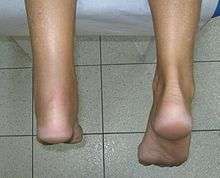Simmonds' test

Left Achilles tendon rupture
Simmonds' test (also called the Thompson test or Simmonds-Thompson test) is used in lower limb examination to test for the rupture of the Achilles tendon.[1][2] The patient lies face down with feet hanging off the edge of the bed. If the test is positive, there is no movement of the foot (normally plantarflexion) on squeezing the corresponding calf, signifying likely rupture of the Achilles tendon.[3]
Interpretation of results
The Simmonds' test has a positive predictive value of 13.7 and a negative predictive value of less than 0.1.[4]
History
It is named after Franklin Adin Simmonds (1911-1983), an English orthopaedic surgeon at the Rowley Bristow Hospital, Surrey.[5]
References
- ↑ Thompson T (1962). "A test for rupture of the tendo achillis". Acta Orthop Scand. 32 (1-4): 461–5. doi:10.3109/17453676208989608. PMID 13981206.
- ↑ Thompson T, Doherty J (1962). "Spontaneous rupture of tendon of Achilles: a new clinical diagnostic test". J Trauma. 2 (2): 126–9. doi:10.1097/00005373-196203000-00003. PMID 13920945.
- ↑ Scott B, al Chalabi A (1992). "How the Simmonds-Thompson test works". J Bone Joint Surg Br. 74 (2): 314–5. PMID 1544978.
- ↑ Starkey, Chad; Brown, Sara D; Ryan, Jeff (2010). Examination of Orthopedic and Athletic Injuries (Hardback) (3rd ed.). Philadelphia, PA: F.A. Davis. p. 270. ISBN 978-0-8036-1720-9.
- ↑ Simmonds FA (1957). "The diagnosis of the ruptured Achilles tendon". Practitioner. 179 (1069): 56–8. PMID 13453094.
This article is issued from Wikipedia - version of the 9/20/2016. The text is available under the Creative Commons Attribution/Share Alike but additional terms may apply for the media files.